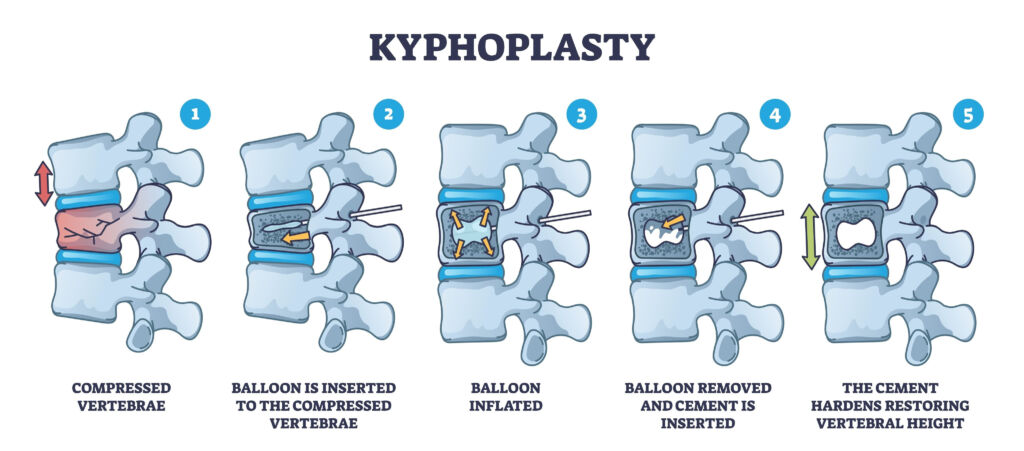Kyphoplasty
Kyphoplasty is a minimally invasive procedure to treat compression fractures of the vertebrae in your spine. It uses a balloon to restore height to the fractured vertebrae and then cement is injected into the space around them to prevent collapse.
You will generally have anesthesia for the procedure. You are awake during the procedure, but cannot feel pain. You may receive medicine to help you relax and feel sleepy as well.
Your doctor will clean your skin and apply medicine to numb the area before placing a needle through your skin and into your vertebra. A real-time x-ray image will be used to guide your doctor’s location of choice for treatment. The balloon is then inflated within this area, restoring height that has been lost due to the compression fracture. Cement is then injected into the space around the vertebrae to prevent further collapse or compression. Imaging is used to ensure the cement is going where it should be. The needle is then removed and bandages are applied.

Why the procedure is performed
Your provider may recommend this procedure if you have a painful compression fracture of the spine due to cancer, injury or an osteoporotic fracture. Injecting bone cement into your vertebra allows the cement to harden around the fracture (cracks in the spine) and helps to stabilize and support your spine so that there is no longer movement of the broken bone, which can cause increased pain.
Risks
Kyphoplasty is a minimally invasive procedure that can help treat vertebral compression fractures (VCFs). It involves injecting a cement into the fractured vertebra to strengthen it and prevent further collapse.
Kyphoplasty has been shown to be effective for treating VCFs. The procedure is generally safe, although some of the following complications may occur:
* Bleeding
* Infection
* Allergic reactions to medicines
* Breathing or heart problems if you have general anesthesia
* Nerve injuries
* Leakage of the bone cement into the surrounding area (this can cause pain if it affects the spinal cord or nerves). Leakage can lead to other treatments (such as surgery) to remove the cement. In general, kyphoplasty has less risk for leakage of cement than vertebroplasty as the cement is placed within the balloon.
Before the procedure
Before surgery, be sure to tell your provider if you could be pregnant, which medications you are taking and even those bought without a prescription, and if you have been drinking a lot of alcohol.
During the days before surgery, you may be asked to stop taking aspirin, ibuprofen, coumadin (Warfarin), and other medicines that make it hard for your blood to clot.
On the day of surgery, you will most often be told not to drink or eat anything for several hours before the procedure. Take the medicines your provider told you to take with a small sip of water. You’ll be told when to arrive.
After the procedure
After the procedure, you may go home on the same day, but will need a driver.
You should not drive until your provider says it is OK.
Avoid heavy lifting and strenuous activities for at least 6 weeks. Apply ice to the wound area if you have pain where the needle was inserted.
Office Hours
Monday: 8 AM - 4:30 PM
Tuesday: 8 AM - 4:30 PM
Wednesday: 8 AM - 4:30 PM
Thursday: 8 AM - 4:30 PM
Friday: 8 AM - 4:30 PM
Saturday: Closed
Sunday: Closed
PROFESSIONAL DOCTORS
Dr. Schell has designed surgical techniques now used by many spinal surgeons.
MODERN EQUIPMENT
The most up-to-date medical equipment, to give you the best care that you deserve.
Professional spinal care and pain care experts are standing by to assist you. If we are not able to answer your question without an on-site appointment, we can schedule one for you.

